Nudibranch
| Nudibranch | |
|---|---|

| |
| Berghia coerulescens | |
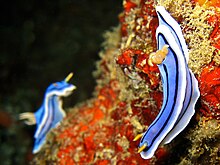
| |
| Chromodoris lochi pair in Puerto Galera, the Philippines | |
| Scientific classification | |
| Domain: | Eukaryota |
| Kingdom: | Animalia |
| Phylum: | Mollusca |
| Class: | Gastropoda |
| Subclass: | Heterobranchia |
| Infraclass: | Euthyneura |
| Subterclass: | Ringipleura |
| Superorder: | Nudipleura |
| Order: | Nudibranchia Cuvier, 1817 |
| Clades | |
| |
| Diversity[1] | |
| About 3000 species | |
Nudibranchs (
The word nudibranch comes from the Latin nudus 'naked' and the Ancient Greek βράγχια (bránkhia) 'gills'.
Nudibranchs are often casually called
Distribution and habitat

Nudibranchs occur in seas worldwide, ranging from the Arctic, through temperate and tropical regions, to the Southern Ocean around Antarctica.[6][7][8] They are almost entirely restricted to salt water, although a few species are known to inhabit lower salinities in brackish water.[9]
Nudibranchs live at virtually all depths, from the intertidal zone to depths well over 700 m (2,300 ft).[7] The greatest diversity of nudibranchs is seen in warm, shallow reefs, although one nudibranch species was discovered at a depth near 2,500 m (8,200 ft).[10]
Nudibranchs are
Anatomical description
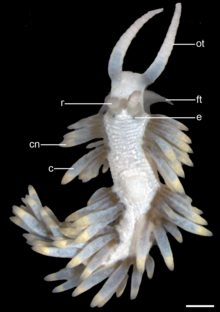
The body forms of nudibranchs vary greatly. Because they are opisthobranchs, unlike most other gastropods, they are apparently
The eyes in nudibranchs are simple and able to discern little more than light and dark.[15] The eyes are set into the body, are about a quarter of a millimeter in diameter, and consist of a lens and five photoreceptors.[16]
Nudibranchs vary in adult size from 4 to 600 mm (0.16 to 23.62 in).[17]
The adult form is without a shell or operculum (in shelled gastropods, the operculum is a bony or horny plate that can cover the opening of the shell when the body is withdrawn). In most species, there is a swimming veliger larva with a coiled shell, but the shell is shed at metamorphosis when the larva transforms into the adult form. Some species have direct development, and the shell is shed before the animal emerges from the egg mass.[14]

The name nudibranch is appropriate, since the dorids (infraclass
Nudibranchs have cephalic (head) tentacles, which are sensitive to touch, taste, and smell. Club-shaped rhinophores detect odors.
Defence mechanisms

In the course of their evolution, nudibranchs have lost their shells, while developing alternative defence mechanisms. Some species evolved an external anatomy with textures and colours that mimicked surrounding sessile invertebrate animals (often their prey sponges or soft corals) to avoid predators (camouflage). Other nudibranchs, as seen especially well on Chromodoris quadricolor, have an intensely bright and contrasting colour pattern that makes them especially conspicuous in their surroundings. Nudibranch molluscs are the most commonly cited examples of aposematism in marine ecosystems, but the evidence for this has been contested,[19] mostly because few examples of mimicry are seen among species, many species are nocturnal or cryptic, and bright colours at the red end of the spectrum are rapidly attenuated as a function of water depth. For example, the Spanish dancer nudibranch (genus Hexabranchus), among the largest of tropical marine slugs, potently chemically defended, and brilliantly red and white, is nocturnal and has no known mimics.[20] Other studies of nudibranch molluscs have concluded they are aposematically coloured, for example, the slugs of the family Phylidiidae from Indo-Pacific coral reefs.[21]
Nudibranchs that feed on hydrozoids can store the hydrozoids'
Nudibranchs use a variety of chemical defences to aid in protection,[24] but it is not necessary for the strategy to be lethal to be effective; in fact, good arguments exist that chemical defences should evolve to be distasteful rather than toxic.[25] Some sponge-eating nudibranchs concentrate the chemical defences from their prey sponge in their bodies, rendering themselves distasteful to predators.[20][26] One method of chemical defense used by nudibranchs are secondary metabolites, which play an important role in mediating relationships among marine communities.[27] The evidence that suggests the chemical compounds used by dorid nudibranchs do in fact come from dietary sponges lies in the similarities between the metabolites of prey and nudibranchs, respectively. Furthermore, nudibranchs contain a mixture of sponge chemicals when they are in the presence of multiple food sources, as well as change defence chemicals with a concurrent change in diet.[28] This, however, is not the only way for nudibranchs to develop chemical defences. Certain Antarctic marine species defense mechanisms are believed to be controlled by biological factors like predation and competition, and selective pressures.[27] Certain species are able to produce their own chemicals de novo without dietary influence. Evidence for the different methods of chemical production comes with the characteristic uniformity of chemical composition across drastically different environments and geographic locations found throughout de novo production species compared to the wide variety of dietary and environmentally dependent chemical composition in sequestering species.[29]
Another method of protection is the release of the ugdon acid from the skin.[30] Once the specimen is physically irritated or touched by another creature, it will release the mucus automatically, eating the animal from the inside out.
Apparent production of sound
In 1884, Philip Henry Gosse reported observations by "Professor Grant" (possibly Robert Edmond Grant) that two species of nudibranchs emit sounds that are audible to humans.[31]
Two very elegant species of Sea-slug, viz., Eolis punctata [i.e. Facelina annulicornis], and Tritonia arborescens [i.e. Dendronotus frondosus], certainly produce audible sounds. Professor Grant, who first observed the interesting fact in some specimens of the latter which he was keeping in an aquarium, says of the sounds, that 'they resemble very much the clink of a steel wire on the side of the jar, one stroke only been given at a time, and repeated at intervals of a minute or two; when placed in a large basin of water the sound is much obscured, and is like that of a watch, one stroke being repeated, as before, at intervals. The sound is longest and most often repeated when the Tritonia are lively and moving about, and is not heard when they are cold and without any motion; in the dark I have not observed any light emitted at the time of the stroke; no globule of air escapes to the surface of the water, nor is any ripple produced on the surface at the instant of the stroke; the sound, when in a glass vessel, is mellow and distinct.' The Professor has kept these Tritonia alive in his room for a month, and during the whole period of their confinement they have continued to produce the sounds with very little diminution of their original intensity. In a small apartment they are audible at the distance of twelve feet. The sounds obviously proceed from the mouth of the animal; and at the instant of the stroke, we observe the lips suddenly separate, as if to allow the water to rush into a small vacuum formed within. As these animals are hermaphrodites, requiring mutual impregnation, the sounds may possibly be a means of communication between them, or, if they are of an electric nature, they may be the means of defending from foreign enemies one of the most delicate, defenceless, and beautiful Gasteropods that inhabit the deep.
Life cycle
This section needs expansion. You can help by adding to it. (January 2018) |

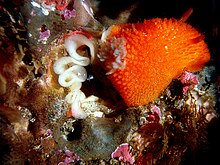
Nudibranchs are hermaphroditic, thus having a set of reproductive organs for both sexes, but they cannot fertilize themselves.[32] Mating usually takes a few minutes, and involves a dance-like courtship. Nudibranchs typically deposit their eggs within a gelatinous spiral,[33] which is often described as looking like a ribbon. The number of eggs varies; it can be as few as just 1 or 2 eggs (Vayssierea felis) or as many as an estimated 25 million (Aplysia fasciata[citation needed]). The eggs contain toxins from sea sponges as a means of deterring predators.[34] After hatching, the infants look almost identical to their adult counterparts, albeit smaller. Infants may also have fewer cerata. The lifespan of nudibranchs can range from a few weeks to a year, depending on the species.
Feeding and ecological role
All known nudibranchs are
The surface-dwelling nudibranch,
Taxonomy
Nudibranchs are commonly divided into two main kinds, dorid and aeolid (also spelled eolid) nudibranchs:[41][42]
- Dorids (clade Anthobranchia, Doridacea, or Doridoidea) are recognised by having an intact digestive gland and the feather-like branchial (gill) plume, which forms a cluster on the posterior part of the body, around the anus. Fringes on the mantle do not contain any intestines.[citation needed] Additionally, dorid nudibranchs commonly have distinct pockets, bumps, and/or mantle dermal formations, which are distortions on their skin, used to store bioactive defense chemicals.[43]
- Aeolids (clade zooxanthellae.
The exact systematics of nudibranchs are a topic of recent revision. Traditionally, nudibranchs have been treated as the order Nudibranchia, located in the
Traditional hierarchy
This classification was based on the work of Johannes Thiele (1931),[48] who built on the concepts of Henri Milne-Edwards (1848).[49]

Order Nudibranchia:
- Infraorder Anthobranchia Férussac, 1819 (dorids)
- Superfamily Doridoidea Rafinesque, 1815
- Superfamily DoridoxoideaBergh, 1900
- Superfamily Onchidoridoidea Alder & Hancock, 1845
- Superfamily Polyceroidea Alder & Hancock, 1845
- Infraorder Cladobranchia Willan & Morton, 1984 (aeolids)
- Superfamily Aeolidioidea J. E. Gray, 1827
- Superfamily Arminoidea Rafinesque, 1814
- Superfamily Dendronotoidea Allman, 1845
- Superfamily Metarminoidea Odhner in Franc, 1968
Early revisions
Newer insights derived from morphological data and gene-sequence research seemed to confirm those ideas. On the basis of investigation of 18S rDNA sequence data, strong evidence supports the monophyly of the Nudibranchia and its two major groups, the Anthobranchia/Doridoidea and Cladobranchia.[50] A study published in May 2001, again revised the taxonomy of the Nudibranchia.[51] They were thus divided into two major clades:
- Bathydoridoidea+ Doridoidea)
- Dexiarchia nom. nov. (= Doridoxoidea + Dendronotoidea + Aeolidoidea + "Arminoidea").
However, according to the taxonomy by Bouchet & Rocroi (2005), currently the most up-to-date system of classifying the gastropods, the Nudibranchia are a subclade within the clade of the Nudipleura. The Nudibranchia are then divided into two clades:
- Euctenidiacea(= Holohepatica)
- Gnathodoridacea (contains only Bathydorididae)
- Doridacea
- Doridoidea
- Phyllidioidea
- Onchidoridoidea
- Polyceroidea (= Phanerobranchiata Non Suctoria)
- Dexiarchia (= Actenidiacea)
- Pseudoeuctenidiacea ( = Doridoxida)
- Cladobranchia ( = Cladohepatica)
- Euarminida
- Dendronotida
- Aeolidida
- Unassigned Cladobranchia (previously Metarminoidea)
- Charcotiidae
- Dironidae
- Goniaeolididae
- Heroidae
- Proctonotidae
- Madrellidae
- Pinufiidae
- Embletoniidae
- Pseudoeuctenidiacea ( =
Gallery
This gallery shows some of the great variability in the color and form of nudibranchs, and nudibranch egg ribbons.
-
Sea clown (Triopha catalinae), Northern California
-
Chromodoris annae from Lembeh Straits, Indonesia
-
Spanish dancer, taken at night, Red Sea
-
Nembrotha chamberlaini from Verde Island, the Philippines
-
Glossodoris atromarginata
-
Chromodoris dianae from Verde Island, the Philippines
-
A pair of Nembrotha milleri mating at Verde Island, the Philippines
-
Regal sea goddess (Felimare picta) in the Gray's Reef National Marine Sanctuary, Savannah, Georgia
-
Flabellina affinis at La Herradura (Mediterranean Sea), Spain
-
Dorid nudibranch egg ribbon in Moss Beach, California
-
Nudibranch egg ribbon at Shaab Mahmoud (Red Sea), Egypt
-
Nudibranch egg ribbon at Malahi (Red Sea), Egypt
-
Goniobranchus kuniei, off the coast of Papua New Guinea
-
Nudibranch
See also
References
- PMID 15715915.
- ISBN 0-582-36467-1
- S2CID 86275359.
- ^ Turnbull, John (Spring 2016). "The Nudibranch – Creature Feature". Nature New South Wales. 60 (3): 16–17.
- ^ Bronson, Wilfrid. Water People, 1935
- ^ a b Ocean Portal (2017). A Collage of Nudibranch Colors. Smithsonian National Museum of Natural History. Retrieved 17 April 2018.
- ^ a b c Nudibranchs Archived 2013-08-14 at the Wayback Machine, Fishermen Scuba.
- .
- PMID 29538398.
- ^ "Discoveries of deep-sea biomass and biodiversity using an ROV". Monterey Bay Aquarium Research Institute. Archived from the original on 9 October 2013. Retrieved 16 October 2013.
- ^ Steinberg, J. E. (1956). "The pelagic nudibranch, Cephalopyge trematoides (Chun, 1889), in New South Wales with a note on other species in this genus". Proceedings of the Linnean Society of New South Wales. 81: 184–192.
- ^ G.M. Mapstone & M.N. Arai, Siphonophora (Cnidaria, Hydrozoa) of Canadian Pacific Waters, p.33. "The best documented predators of pelagic cnidarians from the phylum Mollusca are the neustonic nudibranchs and snails [...and] the pelagic nudibranch [...]"
- ^ Gosliner TM, Valdes A Behrens DW 2015 Nudibranch and Sea Slug Identification Indo-Pacific New World Publications Jacksonville Florida USA
- ^ a b Thompson, T. E. 1976. Biology of opisthobranch molluscs, vol. 1, 207 pp., 21 pls. Ray Society, no. 151.
- ^ "Nudibranchs – National Geographic Magazine". Ngm.nationalgeographic.com. 2013-04-25. Archived from the original on June 17, 2008. Retrieved 2013-07-04.
- PMID 4847278.
- ^ "Hexabranchus sanguineus | DORIS". doris.ffessm.fr. Retrieved 2023-04-17.
- S2CID 53557429. Retrieved 2009-06-14.
- ^ Edmunds, M. (1991). "Does warning colouration occur in nudibranchs?". Malacologia. 32: 241–255.
- ^ .
- .
- ^ Frick, K (2003). "Predator Suites and Flabellinid Nudibranch Nematocyst Complements in the Gulf of Maine". In: SF Norton (Ed). Diving for Science...2003. Proceedings of the American Academy of Underwater Sciences (22nd Annual Scientific Diving Symposium). Archived from the original on January 29, 2009. Retrieved 2008-07-03.
{{cite journal}}: CS1 maint: unfit URL (link) - ^ "Extreme autotomy and whole-body regeneration in photosynthetic sea slugs: Current Biology".
- ISBN 978-3-642-72728-3., a comprehensive review of the chemical ecology of the nudibranchs
- ^ Pawlik, JR (2012). Fattorusso, E.; et al. (eds.). Antipredatory defensive roles of natural products from marine invertebrates. NY: Springer Science. pp. 677–710.
{{cite book}}:|work=ignored (help) - ISBN 978-0-930118-13-6.
- ^ PMID 10962063.
- .
- S2CID 35384332.
- ^ Edmunds, M. (1968). "Acid secretion in some species of Doridacea (Mollusca, Nudibranchia)". Proceedings of the Malacological Society of London. 38 (2): 121–133. Archived from the original on 2013-04-15.
- ^ P.H. Gosse, Evenings at the Microscope, 1884 edition,[1] p57
- ^ a b "Nudibranch". Aquaticcommunity.com. Retrieved 2013-07-04.
- .
- ^ "Diving with Nudibranchs". Dive the World.
- ^ NC Folino (1997). "The role of prey mobility in the population ecology of the nudibranch Cuthona nana (Gastropoda: Opisthobranchia)" (PDF). American Malacological Bulletin. Archived from the original (PDF) on 2012-06-25. Retrieved 2013-03-07.
- ^ .
- ^ Rudman, W.B. (1999-03-19). "Favorinus tsuruganus Baba & Abe, 1964. [In] Sea Slug Forum. Australian Museum".
- ^ .
- JSTOR 1986.
- Greenwood Press.
- ^ a b Hans Bertsch, Nudibranchs: Marine slugs with verve. "Navanax inermis[..] is the bane of all nudibranchs, because it is one of the few known predators on this group of slugs. [...] Dorids mainly eat sponges, bryozoans, and tunicates, whereas aeolids principally eat cnidarians."
- ^ "Facts About Nudibranchs". Marinelife.about.com. 2011-11-10. Retrieved 2013-07-04.
- PMID 29135002.
- PMID 27977703.
- ^ Taxonomy of the Gastropoda, Bouchet & Rocroi, 2005
- ^ Poppe, Guido T.; Tagaro, Sheila P. (February 23, 2006). "The New Classification of Gastropods according to Bouchet & Rocroi, 2005" (PDF). Visaya. Archived from the original (PDF) on September 27, 2007.
- PMID 20973994.
At the basis of the Euthyneura the Nudipleura split off
- ^ Thiele, J. (1931). Handbuch der systematischen Weichtierkunde, II. Verlag von Gustav Fischer, Jena, Germany.
- ^ Milne-Edwards H (1848). Note sur la classification naturelle chez Mollusques Gasteropodes. Annales des Sciences Naturelles, series 3, 9: 102-112.
- .
- .
- ^ "Family Phyllidiidae". ryanphotographic.com. Retrieved 2023-05-07.
Further reading
- Thompson, T. E. (1976). Biology of opisthobranch molluscs Vol. 1. 207 pp., 21 pls. Ray Society, no. 151.
- Thompson, T. E., & G. H. Brown (1984). Biology of opisthobranch molluscs Vol. 2. 229 pp., 41 pls. Ray Society, no. 156.
- McDonald, Gary R. (7 July 2021). Institute of Marine Sciences. Bibliographia Nudibranchia, 3rd online Edition. A listing, by Author, of publications on nudibranchs.
- McDonald, Gary R. (7 July 2021). Institute of Marine Sciences. Nudibranch Systematic Index, 3rd online Edition. An index of names given to nudibranchs and their subsequent use, referenced to Bibliographia Nudibranchia.
- McDonald, Gary R. & J. W. Nybakken. (November 5, 2014). List of the Worldwide Food Habits of Nudibranchs
- Coleman, Neville (2008). Nudibranchs Encyclopedia: Catalogue of Asia/Indo-Pacific Sea Slugs. Neville Coleman's Underwater Geographic. ISBN 0-947325-41-7
External links
- Sea Slug Forum by William B. Rudman
- Nudibranchs of the British Isles
- OPK Opistobranquis – Iberian and Mediterranean Opisthobranchs
- Mediterranean slug site (actually a misnomer) – Worldwide coverage
- The Slug Site, Michael D. Miller 2002–2014
- The Okinawa Slug Site
- Images, information and identification of Nudibranchs
- Nudibranch Photos by Mick Tait
- Nudibranchs in their natural environment, Scuba Diving – Narooma NSW offline? 26 Nov 2014
- Nudi Pixel: Online resource for nudibranchs and sea slugs identification using photographs Archived 2011-05-27 at the Wayback Machine
- Various nudibranch species from Indonesia, Philippines and Thailand
- Nudibranch gallery- Sergey Parinov – offline? 26 Nov 2014
- Opisthobranch Newsletter – Bibliography and portal to opisthobranch, nudibranch & seaslug information
- Scottish Nudibranchs: Online resource for identification of species found in Scottish waters
- National Geographic Nudibranch Photo Gallery
- Sea Slugs of Hawaii
- Slug City – Molluscs. Brain & Behavior, from the University of Illinois at Urbana-Champaign
Videos
- Attack of the Sea Slugs at YouTube
- The Lynx Nudibranch: HD clip of Phidiana lynceus carefully consuming a hydroid Myrionema amboinense.
- Slug City – Molluscs. Brain & Behavior: many videos of nudibranchs from the University of Illinois at Urbana-Champaign


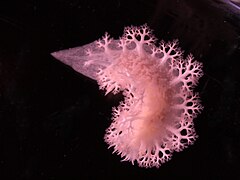
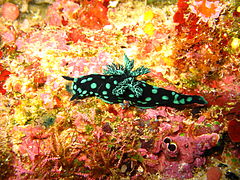







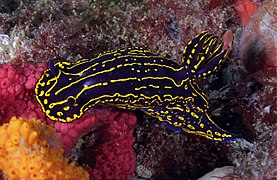




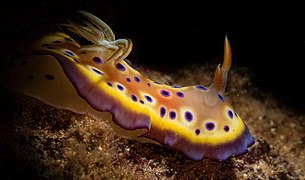

![Mushroom coral reticulidia (Reticulidia fungia, at Wakatobi National Park, Indonesia, 2018[52]](http://upload.wikimedia.org/wikipedia/commons/thumb/f/ff/Mushroom_coral_reticulidia_with_an_orange_stowaway%2C_pantai_kollo_soha%2C_wakatobi%2C_2018_%2845088582314%29.jpg/270px-Mushroom_coral_reticulidia_with_an_orange_stowaway%2C_pantai_kollo_soha%2C_wakatobi%2C_2018_%2845088582314%29.jpg)